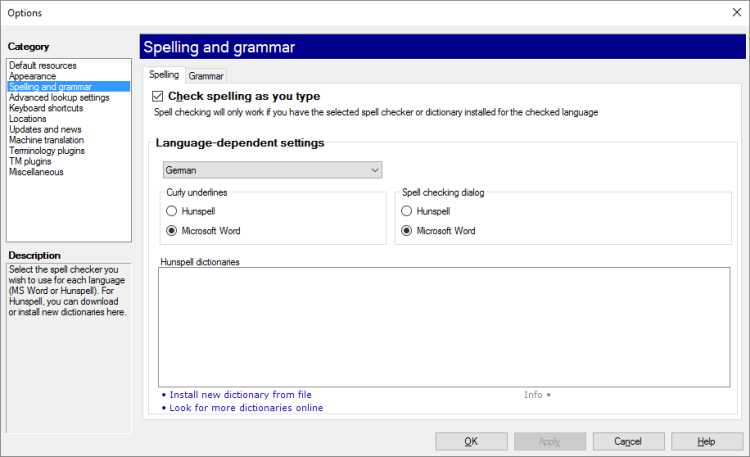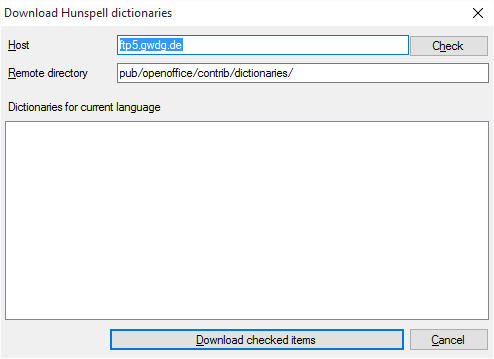Options: Spelling and grammar
To use spell checking in memoQ, you need to set up the spell checker for each target language you work with. You can do this on the Spelling and grammar pane of the Options window.
If Microsoft Word is there on your computer, memoQ can use Word's spell checkers. If Word is not on the computer, or it does not have a spell checker for the language you need, you can set up Hunspell for that language.
If Microsoft Word is on your computer, and it supports grammar checking for your target language, memoQ can also check the grammar of your translation.
Microsoft Word is using its own options in memoQ. To change the way Word checks spelling, open the Options window in Microsoft Word, click the Proofing category, and change those settings as needed.
How to get here
- Open the Options window: At the very top of the memoQ window - in the Quick Access toolbar
 -, click the Options (cogwheels)
-, click the Options (cogwheels)  icon. The Options window opens.
icon. The Options window opens. - Under Category, click Spelling and grammar. The Spelling and grammar pane appears.

What can you do?
- To do this, click the Spelling tab.
- Under Language-dependent settings, choose a language from the drop-down box.
There are two ways to check spelling in memoQ: continuous spell checking will underline unrecognized words as you type; or the Spell checking window where you can go through any unrecognized words one by one. You need to choose a spell checker separately for the two methods.
For both the underlines and the Spell checking window, you can choose Hunspell or Microsoft Word. For example, it is possible to use Hunspell for the underlines, and Word for the Spell checking window, although this is not recommended.
- If you have Word, and it has a spell checker for your language, it is always recommended to use the Microsoft Word setting. Click the Microsoft Word radio button both under Curly underlines and under Spell checking dialog. You are ready: memoQ can check spelling in the selected language.
Use Hunspell only if you do not have Word or it has no spelling checker for your language.
- Under Curly underlines and under Spell checking dialog, click Hunspell. (Do this at both places.)
- If you have not used Hunspell for this language before, the Hunspell dictionaries box will be empty.
- Click Look for more dictionaries online. The Download Hunspell dictionaries window opens.

- Next to the Host box, click Check. memoQ will look for suitable dictionaries on the internet, and list them under Dictionaries for current language.
- In the list, check the check box for the item that matches your language best. If you are uncertain which to choose, check all check boxes.
- Click Download checked items. memoQ will download and install the dictionaries for the selected language.
If Check or Download does not work: Contact memoQ support. Or, look for another OpenOffice download site on the internet, and check if it has the Hunspell dictionaries. Then you can specify the server's address in the Host box, and the folder within the server in the Remote directory box. Do this only if you have sufficient expertise.
After the dictionaries are downloaded, your spell checker is ready for work.
You can turn off continuous spell checking: Normally, memoQ keeps checking your text as you type, and underline any unrecognized words. You can turn this off: On the Spelling tab, clear the Check spelling as you type check box.
To do this, click the Grammar tab.
memoQ can check your grammar only if you have Microsoft Word, and your copy of Word has a grammar checker for your target language.
Normally, memoQ will not check grammar even then.

- To turn on continuous grammar checking: Check the Check grammar as you type check box. memoQ will underline potential grammar problems with blue curly underlines.
- To check grammar together with spelling: This works in the Spell checking window. To turn this on, check the Check grammar with spelling check box.
When you finish
To save the settings and return to memoQ: Click OK.
To save the settings and remain in the Options window: Click Apply.
To return to memoQ without making changes: Click Cancel.
- Default resources: Choose default resources (segmentation rules, QA settings, ignore lists etc.) for new projects. Do not mix these with resources in project templates. If you create a project from a template, memoQ will use the settings from the template, and not from these options.
- Appearance: Font and color settings for the translation editor and the Translation results pane. Use this to make the translation editor more readable.
- Spelling and grammar: Open this to set up the spell checker. Choose to use Word or Hunspell. If you choose Hunspell, you can download and install new dictionaries. Set up the spell checker for every target language you work with.
- Advanced lookup settings: Choose how memoQ should offer automatic concordance results, and how it should put together suggestions from fragments (shorter translation memory units and terms). Do not change the defaults unless you are entirely certain that you will get better suggestions as a result. If you just tamper with these settings, you may lose productivity. To learn more about these types of suggestions, see Help about the Translation results pane.
- Keyboard shortcuts: Choose or edit keyboard shortcuts for frequent commands in memoQ. Do not change these before you learn to use memoQ thoroughly. After you change keyboard shortcuts, the Help pages may not help you find them.
- Locations: Check or change the locations of memoQ folders. These are the folders memoQ places local projects and checkouts, translation memories, term bases, and others. You may need to change these if you are running low on disk space on your default drive. Do not change them unless it is absolutely necessary. Do not place them on network drives. If you place these folders in synchronized locations (local copies of Dropbox, Onedrive etc.), memoQ may become slower.
- Updates and news: Choose how memoQ should check for updates, and opt out of receiving news if necessary.
- Terminology plugins: Set up external terminology resources. memoQ can connect to various external terminology providers.
- TM plugins: Set up access to external translation memory services.
- External preview tools: Manage preview tools that are not built into memoQ, but installed separately.
- Miscellaneous: Configure various settings that control the behavior of the editing interface of memoQ.
- Privacy: Learn about memoQ's privacy policy, and enable or disable anonymous usage data sharing with memoQ's designers and developers.